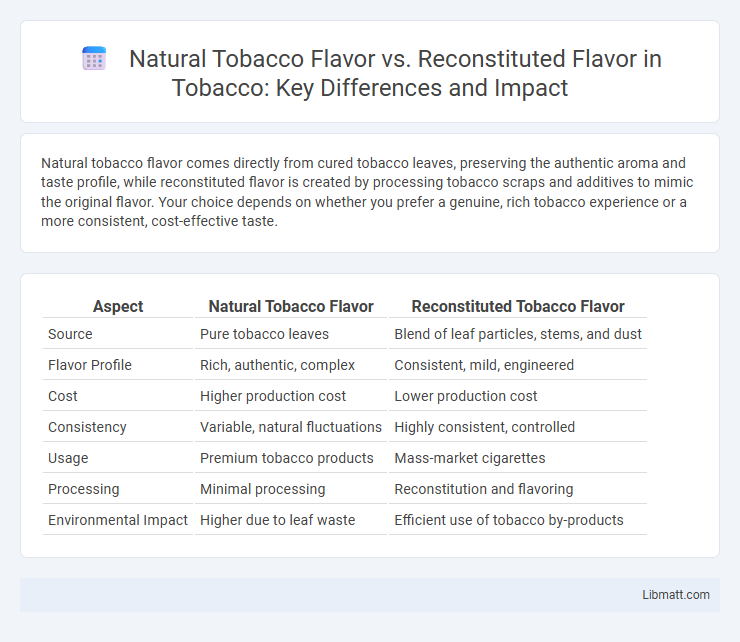Natural tobacco flavor comes directly from cured tobacco leaves, preserving the authentic aroma and taste profile, while reconstituted flavor is created by processing tobacco scraps and additives to mimic the original flavor. Your choice depends on whether you prefer a genuine, rich tobacco experience or a more consistent, cost-effective taste.
Table of Comparison
| Aspect | Natural Tobacco Flavor | Reconstituted Tobacco Flavor |
|---|---|---|
| Source | Pure tobacco leaves | Blend of leaf particles, stems, and dust |
| Flavor Profile | Rich, authentic, complex | Consistent, mild, engineered |
| Cost | Higher production cost | Lower production cost |
| Consistency | Variable, natural fluctuations | Highly consistent, controlled |
| Usage | Premium tobacco products | Mass-market cigarettes |
| Processing | Minimal processing | Reconstitution and flavoring |
| Environmental Impact | Higher due to leaf waste | Efficient use of tobacco by-products |
Understanding Natural Tobacco Flavor
Natural tobacco flavor is derived directly from cured tobacco leaves, preserving the authentic taste and aroma unique to specific tobacco varieties. Reconstituted tobacco flavor, in contrast, is created by processing tobacco stems and dust into sheets, allowing manufacturers to control consistency and intensity while reducing waste. Understanding natural tobacco flavor involves recognizing its complex, nuanced profile that contributes to a richer, more genuine smoking experience compared to the more uniform, engineered character of reconstituted alternatives.
What Are Reconstituted Tobacco Flavors?
Reconstituted tobacco flavors are created by processing tobacco leaf materials, stems, and dust into sheets that are then flavor-enhanced to mimic or complement natural tobacco characteristics. This technique allows manufacturers to utilize by-products and control flavor consistency while reducing waste. Unlike natural tobacco flavors derived directly from whole leaves, reconstituted flavors offer a customizable profile tailored for specific sensory experiences in tobacco products.
Composition Differences: Natural vs. Reconstituted Tobacco
Natural tobacco flavor derives from whole tobacco leaves containing intact fibers, oils, and essential compounds that provide a rich and authentic taste profile. Reconstituted tobacco flavor is created by blending tobacco leaf scraps, stems, and dust with additives and binders to form a uniform sheet, resulting in a more controlled but less complex aroma. Understanding these composition differences helps you choose the right tobacco flavor that suits your preferences and desired sensory experience.
Flavor Profile Comparison
Natural tobacco flavor offers a rich, authentic taste characterized by complex, earthy, and slightly sweet notes derived directly from cured tobacco leaves. Reconstituted tobacco flavor tends to have a more uniform, consistent taste with milder, less nuanced profiles due to the processing of tobacco leaf pulp combined with additives for flavor enhancement. The natural flavor provides depth and variability, while reconstituted flavor excels in stability and cost efficiency but often lacks the full-bodied richness found in natural tobacco.
Manufacturing Processes and Their Impact on Taste
Natural tobacco flavor derives directly from cured tobacco leaves, preserving the leaf's original aromatic compounds through drying and aging processes that emphasize authenticity and complexity in taste. Reconstituted tobacco flavor uses processed components like tobacco leaf pulp, stems, and powders combined with additives, creating a more uniform and consistent flavor profile but often lacking the nuanced depth of natural tobacco. Your choice between these flavors impacts the sensory experience, as manufacturing methods significantly influence the richness, smoothness, and overall character of the final tobacco product.
Consumer Preferences: Natural or Reconstituted?
Consumer preferences often lean towards natural tobacco flavor due to its authentic taste and perceived purity, enhancing overall satisfaction in smoking or vaping experiences. Reconstituted tobacco flavor, while offering cost efficiency and consistency, sometimes faces criticism for a less complex or artificial profile compared to natural tobacco leaves. Market studies indicate that a significant segment values natural tobacco flavor for its rich aroma and genuine sensory experience, influencing product development in the tobacco industry.
Health Implications of Flavoring Choices
Natural tobacco flavor contains fewer synthetic additives, potentially reducing exposure to harmful chemicals compared to reconstituted flavor, which often includes processed materials and chemical binders. Health implications of reconstituted tobacco flavoring may involve increased risk of respiratory irritation and toxin inhalation due to the presence of flavor enhancers and stabilizers. Your choice between these flavoring types can influence the levels of harmful substances consumed, impacting overall lung health and potential long-term effects.
Regulatory Perspectives on Tobacco Flavors
Regulatory agencies often scrutinize natural tobacco flavors and reconstituted tobacco flavors differently, with several jurisdictions imposing restrictions based on flavor additives to reduce tobacco product appeal, especially among youth. Natural tobacco flavors, derived directly from cured tobacco leaves, are sometimes subject to less stringent regulations compared to reconstituted flavors, which may involve additives to enhance or mimic natural taste profiles. Understanding regulatory frameworks, including the FDA's assessments and the EU Tobacco Products Directive, is essential for compliance and market strategy in the tobacco industry.
Industry Trends: Shifts in Flavor Use
The tobacco industry is increasingly shifting from natural tobacco flavor to reconstituted tobacco flavor due to cost-efficiency and consistent quality. Reconstituted tobacco flavor offers manufacturers better control over taste profiles by blending leaf extracts and additives, aligning with consumer demand for standardized products. Market trends indicate a growing preference for reconstituted flavors in cigarette production, driven by regulatory pressures and sustainability concerns associated with natural tobacco cultivation.
Future Outlook: Innovations in Tobacco Flavoring
Innovations in tobacco flavoring emphasize enhancing natural tobacco extracts to preserve authentic taste while reducing harmful components, meeting increasing consumer demand for cleaner products. Advances in biotechnology enable more precise extraction and blending techniques, improving flavor consistency and customization options in both natural and reconstituted tobacco. Your experience will benefit from these developments as the industry shifts toward sustainable, high-quality flavor profiles driven by scientific research and regulatory compliance.
natural tobacco flavor vs reconstituted flavor Infographic

 libmatt.com
libmatt.com